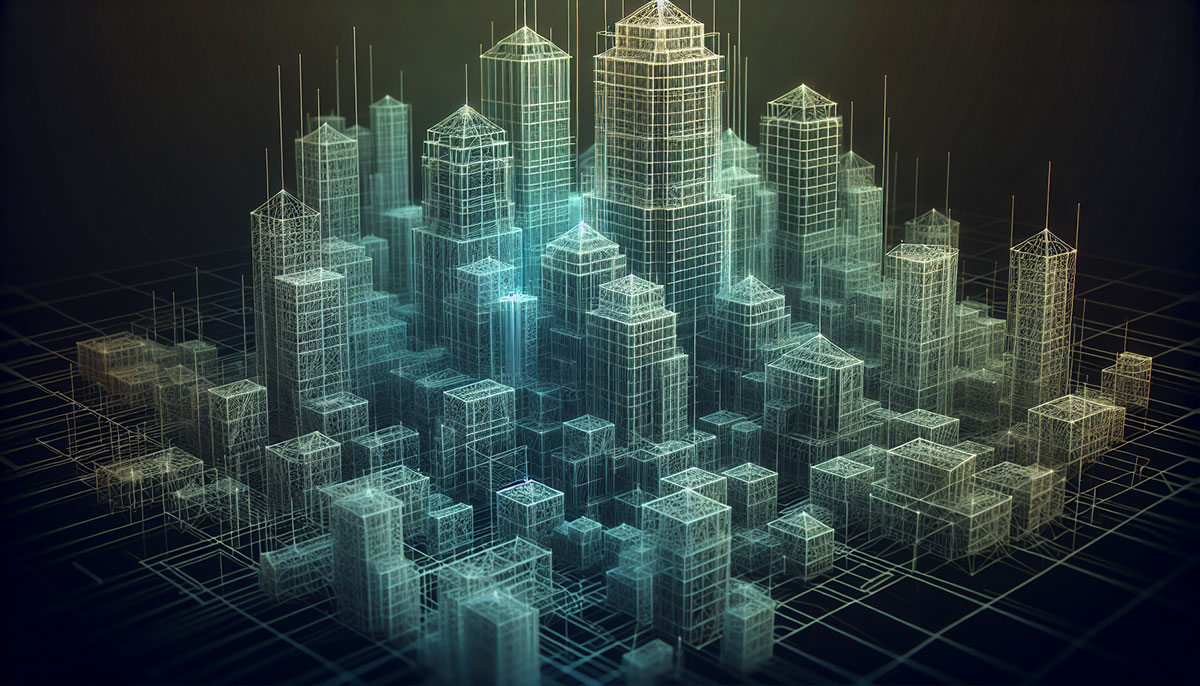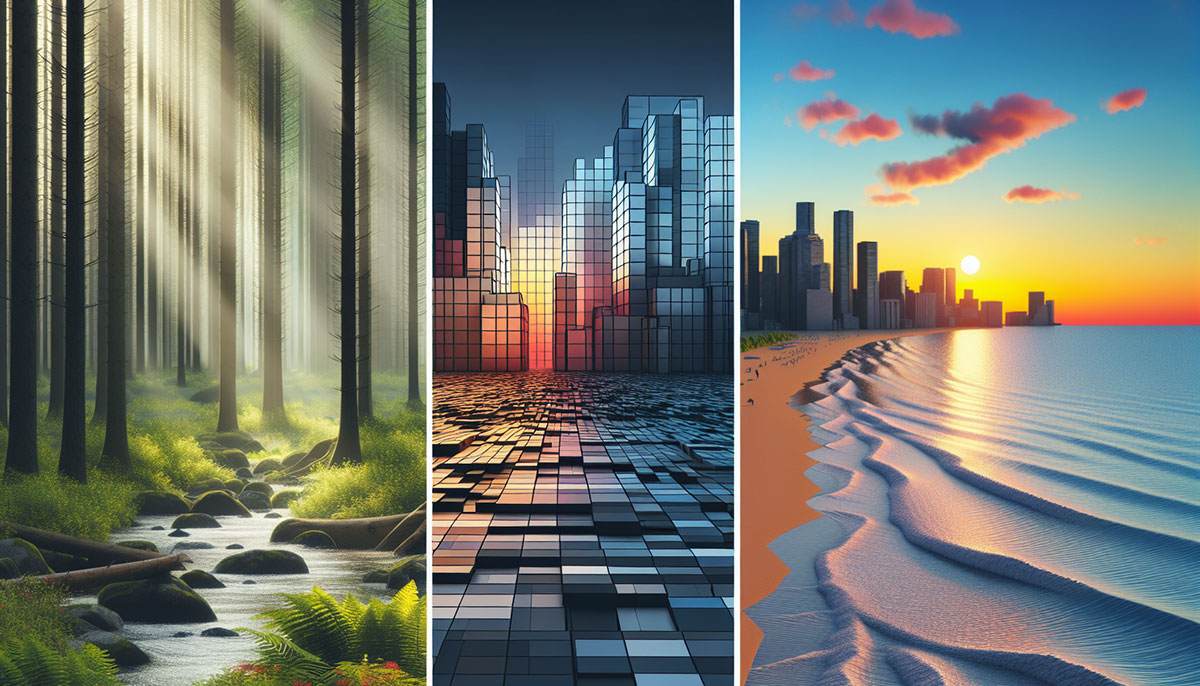Rendering Explained: Understanding the Process and Its Impact

Arqsix
April 8th, 2024

Rendering is the transformative process that takes a 3D model and converts it into a comprehensible visual image. Whether in architecture, game design, or 3D animation, rendering is pivotal for bringing virtual concepts to life, allowing us to preview and refine our designs with stunning clarity. In this article, discover the essential techniques and technologies that drive rendering, explore how it shapes our visual and virtual experiences, and learn how advancements in this field are redefining what’s possible for creators across industries.
Key Takeaways
Rendering is a critical process in architecture where a 3D model is converted into a visual representation that can help stakeholders visualize and make informed decisions about a construction project, and can also serve as a compelling marketing tool.
The rendering process involves essential components like geometry, lighting, and materials that work together to produce a realistic or stylized visual output, with techniques such as ray tracing, rasterization, and radiosity each providing a unique approach to visualization.
Technological advancements in AI and neural rendering are shaping the future of the field, with new capabilities such as photogrammetry and 3D model generation from text or paintings, leading to more efficient, accurate, and accessible rendering processes.
The Art of Rendering: An Overview
 Created by Arqsix
Created by Arqsix
Picture an architect, armed with a vision for a grand building. How does she communicate this vision to her clients, the construction team, or potential investors? Here’s where the magic of rendering steps in, transforming the architect’s vision into a vivid depiction that everyone can understand and appreciate.
Rendering, in essence, is about making an idea ‘given back’ or ‘presented’ as a visual output. It’s like a coat of plaster that gives form and structure to the bare bones of a 3D model, making it visible and easy to understand, serving as a rendering noun.
But what role does render aid play in architecture?
Architectural Visualization
Rendering serves as an indispensable tool in an architect’s toolkit. It’s a process that turns a 3D model into a visualization that provides an accurate representation of what a building will look like, even before a brick is laid. From the grandeur of a finished building to the intricate details of interior design, architectural rendering can depict it all. The visual representation of the finished building enables clients and stakeholders to make informed decisions, fostering improved communication and a seamless construction process.
But that’s not all. High-quality architectural renders can be a potent marketing instrument, effectively showcasing the concept and design to attract potential buyers or investors. Depending on the needs of the project, renderings can range from photorealistic to sketch-style, offering an immersive view of the proposed spaces through still renderings, walk-through animations, and virtual tours. Potential issues that could be overlooked in traditional architectural drawings, such as sunlight angles and layout conflicts, can be identified through rendering, leading to a more seamless construction process.
The interplay of light and shadow in renderings adds depth and dimension, vital in interior design to enhance the overall visual impact.
Essential Components of Rendering
 Created by Arqsix
Created by Arqsix
Rendering is much like creating a painting or a drawing. Just as an artist uses different elements like shapes, colors, and lights to create a final artwork, rendering involves essential components such as geometry, lighting, and materials that together create the final appearance of an image. It’s a process that uses a computer program to generate a photorealistic or non-photorealistic image from a 2D or 3D model.
How do these components synergize to produce a rendered image?
Geometry
 Generated by SurferAI
Generated by SurferAI
Geometry forms the backbone of any 3D model, providing it with its basic shape and structure. In rendering, geometry is handled using various techniques like ray casting, which parses the modeled geometry pixel by pixel, line by line, from the viewer’s perspective. Think of it as creating a wireframe model of a building. Each line represents an edge, and where the lines intersect, we have vertices. The faces formed by these lines and vertices create a mesh, which can be manipulated to create curves and fine-tune the shape to achieve realistic design renders.
These meshes are made using polygons like hexagons, pentagons, diamonds, rectangles, and triangles, which together form basic shapes. Primitive shapes like cubes, cylinders, spheres, cones, and pyramids are utilized as foundational elements for constructing complex models. To ensure the created 3D model accurately reflects the original design, attention is given to reference points, proportions, and measurements, maintaining realism within the model’s representation. It’s like creating a highly detailed and accurate miniature model of a building.
Lighting
 Created by Arqsix
Created by Arqsix
Lighting in rendering is like the sun to our world. It:
Reveals the form and color of the objects
Provides depth
Contributes to the image’s realism by affecting the appearance of materials and creating natural effects through shading
The interplay of light with materials in rendering is complex. Real-world observations and photography of light-material interactions can guide the effective application of textures and materials for additional authenticity. Understanding the interpretation of these interactions is crucial for achieving realistic results. Then there is also the aspect of windows, mirrors and any other surface that behaves slightly differently when it comes to light.
With the advent of real-time ray tracing, lighting in rendering has taken a leap forward, providing highly realistic interactions with light, such as accurate reflections and soft shadows, enhancing the immersion in virtual environments. Imagine walking through a virtual building and seeing the light bounce off the polished marble floor, casting soft shadows on the walls and ceiling. Such realistic lighting effects can significantly enhance the viewer’s experience and emotional response.
Only the right person and artist can give justice to these types of lightings though, as it takes a good eye for someone to make it just right.
Materials and Textures
Applying appropriate materials and textures, such as plaster applied, is like adding the final coat of paint to a sculpture. These elements enhance the realism of the model, providing it with a lifelike appearance and making it easier for viewers to understand what the final product will look like. Just as an artist uses different brushes and techniques to create texture on a canvas, renderers use texture/bump mapping to wrap a texture around a 3D model, conveying information about color, material, and details.
Integrating imperfections such as subtle scratches, smudges, and signs of wear and tear into materials is vital for adding depth and character to the render, thereby making it more realistic. Imagine looking at a virtual wooden floor. Seeing the grain of the wood, the subtle scratches from years of use, and the way the light bounces off the polished surface adds a level of realism that makes the viewer feel as though they could reach out and touch it. This level of detail is what makes rendering such an essential tool in architectural visualization.
Common Rendering Techniques
 Generated by SurferAI
Generated by SurferAI
Just as there are different techniques for painting or sculpting, there are also various techniques for rendering. Some of the most common ones include ray tracing, rasterization, and radiosity, each offering a unique approach to achieving realistic visuals.
We’ll now examine these techniques in detail and explore their contribution to the art of rendering, as they act as essential components in the process.
Ray Tracing
Ray tracing is a technique that simulates how light interacts with objects by tracing the path of light rays, adhering to the principles of geometrical optics. It’s like a game of pool, where the light rays are the balls, and the objects are the walls of the pool table. The light bounces off the objects, creating a network of light paths that provide a high level of realism with effects like:
soft shadows
reflections
refractions
global illumination
However, ray tracing is a computationally intense process requiring significant calculations. To optimize this, computational geometry algorithms manage geometric data efficiently. Thanks to advancements in technology and the introduction of dedicated hardware accelerators, real-time ray tracing is now feasible. It has revolutionized industries like gaming by simulating natural light dynamics and producing realistic effects such as:
Shadows
Reflections
Refractions
Global illumination
These advancements have greatly enhanced the visual quality and immersion of virtual environments.
Rasterization
Rasterization is another popular rendering technique, preferred for real-time 3D engines due to its speed and efficiency. It’s like an artist who quickly sketches the outline of a scene, ignoring the empty spaces and focusing only on the important elements. During the rasterization process, pixel shaders, programmable on modern GPUs, define the final color for each pixel, effectively painting the scene.
While rasterization may not provide the same level of detail as pixel-by-pixel rendering, special techniques and optimizations help achieve realistic visuals efficiently. Adherence to rasterization rules, like the top-left rule in triangle rasterization, ensures that no pixel is missed or rendered more than once, avoiding visual errors.
Radiosity
Radiosity rendering is a technique that involves creating an energy model of light, followed by the application of a suitable rendering algorithm. It’s like a photographer adjusting the settings on a camera to capture the perfect shot, considering not just the light that comes directly from the source but also light reflected from objects in the scene.
The technique employs recursive, finite-element algorithms that simulate the interreflection of light between surfaces, creating natural-looking scenes, particularly in indoor environments. The luminance rendering of radiosity models can show energy levels using a color gradient, visually indicating the light energy distribution within the scene.
This technique is especially effective in capturing secondary and tertiary shadows and penumbra effects, making the scenes more realistic and immersive.
Neural Rendering and Artificial Intelligence
As we step into the future of rendering, we encounter a new player on the field - artificial intelligence. Neural rendering and AI advancements are revolutionizing the rendering process, introducing new capabilities such as photogrammetry and generating 3D models from text and paintings.
How does AI integrate into the realm of rendering?
Photogrammetry
Photogrammetry is a technique that leverages AI to analyze and combine multiple images for creating accurate spatial 3D models from photographs. It’s like piecing together a puzzle, where each piece is a different photograph, and the final image is a 3D model. AI significantly streamlines the photogrammetry process by automating feature identification and matching, reducing manual effort and increasing efficiency.
With AI-powered tools like Polycam and Make3D, the conversion of 2D images into textured high-definition 3D models has become more accessible and efficient. This advancement in photogrammetry is transforming the way we create 3D models, opening up new possibilities for:
architectural visualization
virtual reality experiences
video game development
product design and prototyping
cultural heritage preservation
and beyond.
Generating 3D Models from Text and Paintings
Imagine being able to create a 3D model from a text description or a painting. Sounds impossible, right? Well, with the advancements in AI, this is now becoming a reality. AI can generate 3D models based on text descriptions by interpreting and translating the semantic content within the text into a three-dimensional representation.
When dealing with paintings, AI can analyze elements like artistic style and brushstrokes to infer depth and spatial relationships, resulting in the creation of 3D models that accurately reflect the original artwork’s intended geometry. This capability of AI is like having an interpreter who can understand the language of text and paintings and translate it into the language of 3D models.
How AI Will Change the World of Visualization
As we continue to integrate AI and neural rendering into visualization, we are witnessing a significant shift in the way we create and interpret visual content. From semantic photo manipulation to synthesis of novel views, the applications of neural rendering are vast and varied. AI-powered rendering engines are becoming increasingly capable of creating ultra-realistic visuals by learning from data, influencing sectors such as architecture, film, and product design.
Imagine a future where AI could automate the entire rendering process, creating photorealistic visualizations in a fraction of the time it takes today. This is not just a distant dream, but a foreseeable reality. The integration of AI into rendering is not only changing the way we create visual content, but also how we interact with it. This is the future of rendering, and it’s closer than we think.
Rendering Optimization and Challenges
As with any technology, rendering comes with its own set of challenges and optimization techniques. Some of these techniques include:
Using high-resolution textures to capture detail, but balancing them with rendering performance to reduce computation times
Implementing antialiasing to smooth out edges and enhance image quality
Utilizing sub-pixel precision to produce smoother animations
These techniques help improve the overall rendering process and ensure high-quality results.
How can we fine-tune the rendering process to uphold visual quality and boost efficiency simultaneously?
Level of Detail (LOD)
Level of Detail (LOD) is a method of reducing the number of polygons in 3D objects based on their distance to the viewer or camera, increasing the efficiency of rendering. It’s like adjusting the focus on a camera, where objects closer to the lens are in sharp focus, while the ones in the background are blurred.
LOD meshes can be created either manually by reducing vertices and polygon loops or automatically using 3D software tools or specialized LOD generation software like Simplygon. For optimal implementation in games, there are multiple LOD groups, with LOD0 being fully detailed and subsequent LODs (LOD1, LOD2, etc.) having progressively lower levels of detail. Techniques like culling, which omits polygons not visible in the final scene, help reduce the computational cost of rendering.
Render Farms and Cloud Rendering
Movies require rendering, which is typically done on a network of closely linked computers, referred to as a render farm. This process allows for efficient and intensive rendering tasks to be completed. It’s like having a team of workers, where each computer is an individual worker, contributing to the final output. However, with the advent of cloud technology, rendering has taken a new turn.
Cloud-based rendering solutions are making 3D rendering more accessible and scalable, allowing small businesses and independent creators to utilize powerful rendering capabilities. Imagine being able to access a render farm from your laptop, without the need for expensive hardware or software. This is the power of cloud rendering, providing scalable and accessible rendering capabilities for a wide range of users.
The Future of Rendering Technology
As we look towards the future of rendering technology, we see a world where real-time ray tracing and virtual reality are pushing the boundaries of immersion and realism in virtual environments.
Envision a scenario where you can stroll through a virtual building, observing light reflections on the polished marble floor and soft shadows on the walls and ceiling. Such realism is achievable today thanks to advancements in real-time rendering and virtual reality.
Real-Time Ray Tracing
Real-time ray tracing has revolutionized the gaming industry by providing players with more realistic experiences and increased engagement. This technology simulates natural light dynamics, producing realistic shadows and reflective effects, bringing the virtual world to life. But the application of real-time ray tracing is not limited to gaming. It can also be used in:
Architectural visualization
Product design and prototyping
Film and animation production
Virtual reality experiences
Medical imaging and simulations
The possibilities are endless with real-time ray tracing technology.
With the support of powerful GPUs and advanced algorithms, real-time ray tracing is now feasible for interactive applications, providing highly realistic interactions with light. Combined with real-time rendering engines like Enscape, this technology provides immediate visual feedback, allowing for rapid design iterations in modeling projects. This is a game-changer for industries like architecture, where the ability to quickly visualize and modify designs can significantly enhance the design process.
Virtual Reality and Rendering
Virtual Reality (VR) is another technology that’s transforming the future of rendering. Advancements in VR technology, including increased resolution and more powerful processors, are driving innovation in VR rendering. Imagine being able to walk through a virtual building, touching the walls, feeling the texture of the materials, and seeing the light bounce off the surfaces. This level of immersion is now possible with advancements in VR rendering.
Virtual esports and metaverses represent new frontiers for VR rendering, providing immersive and interactive experiences. These future applications have the potential to significantly influence the gaming industry and how social interactions occur within virtual spaces. As we continue to push the boundaries of VR technology, the possibilities for VR rendering are endless.
Summary
Rendering is an art and a science, blending creativity with technical precision to create stunning visualizations and immersive virtual environments. From the basic components of rendering like geometry, lighting, and materials, to advanced techniques like ray tracing, rasterization, and radiosity, the world of rendering is vast and varied. With the advent of AI and neural rendering, we are witnessing a revolution in the way we create and interpret visual content.
As we look towards the future, we see a world where real-time ray tracing and VR are pushing the boundaries of immersion and realism in virtual environments. With advancements in cloud technology and AI, rendering is becoming more accessible and scalable, opening up new possibilities for small businesses and independent creators. As we continue to innovate and push the boundaries of technology, the future of rendering is bright and full of potential.
FAQs
Our location
Ready to share your expertise?
We welcome submissions from talented writers and experts in various fields who are passionate about sharing their knowledge and insights with our audience.
Write for UsArqsix - Shaping Stories, Shaping Spaces
Elevating real estate marketing for a world that’s always evolving.
2025 © Arqsix. All Rights reserved. |Sitemap|Privacy Notice